Today’s Current Affairs: 13th Sep 2023 for UPSC IAS exams, State PSC exams, SSC CGL, State SSC, RRB, Railways, Banking Exam & IBPS, etc
Table of Contents
Achanakmar Tiger Reserve : Recover Big Cat Numbers
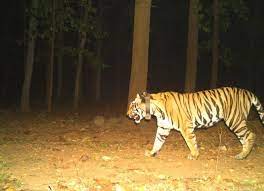
The officials in Achanakmar Tiger Reserve have been trying to recover big cat numbers.
- A recent NTCA report found Chhattisgarh had only 17 tigers compared to 46 in 2014.
- Tracking teams inside Achanakmar Tiger Reserve in Chhattisgarh are undertaking a grueling task keeping tabs on a tigress released in April 2023 to augment the reserve’s falling population of the big cat.
Achanakmar Tiger Reserve:-
- Location: Bilaspur, Chhattisgarh. (Indravati Tiger Reserve)
- Area: approximately 553.286 sq. Km.
- It is a part of the huge Achanakmar-Amarkantak Biosphere Reserve.
- Mountain Ranges: Maikal mountain range
- Water bodies: Maniyari River.
- In 1975, Achanakmar Wildlife Sanctuary was established, under the provisions of the Indian Wildlife Protection Act of 1972.
- In 2005, the Achanakmar-Amarkantak Biosphere Reserve was created by the Government of India.
- It was declared a tiger reserve in 2009.
- Achanakmar-Amarkantak Biosphere Reserve was recognized by UNESCO in 2012 for its biological diversity and cultural significance.
Genetic Engineering To Control Mosquitoes:
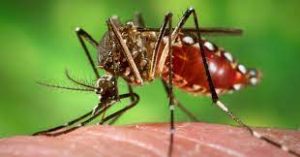
Gene-drive technology has been used in outdoor but controlled conditions in India, Brazil, and Panama to genetically manipulate mosquitoes.
- Researchers at Imperial College London genetically enhanced a gene expressed in the midgut of mosquitoes to secrete two antimicrobial substances called magainin 2 and melittin.
- They are detrimental to the Plasmodium parasite’s development in the midgut and also reduce the lifespan of female mosquitoes.
- Computational modelling studies have suggested that this approach could significantly disrupt malaria transmission.
- Gene-drive technology is a type of genetic engineering technique that modifies genes.
- This technology was conceived by Austin Burt, a professor at Imperial College London.
- This technique could be an effective way to eradicate nuisance species, such as malaria-causing mosquitoes.
- Under this technique, mosquitoes will selectively inherit some genes rather than the inheritance to follow the rules of Mendelian genetics.
- In this, a protein cuts the mosquito’s DNA at a part that doesn’t encode a particular sequence in the genome.
- This triggers a natural mechanism in the cell containing the DNA to repair it and forces the cell to incorporate a sequence called the drive sequence into the damaged portion.
US Open 2023:

Novak Djokovic of Serbia wins his 24th Grand Slam title at the US Open 2023, defeating Daniil Medvedev of Russia.
- He moved ahead of Serena Williams to claim the record for the most major singles titles won in the Open era.
- Grand Slam tournaments, also called majors, are the four most important annual tennis events.
- The Grand Slam itinerary consists of the Australian Open in mid-January, the French Open from around late May to early June, Wimbledon in June–July, and the US Open in August–September.
- The Australian and United States tournaments are played on hard courts, the French on clay, and Wimbledon on grass.
2nd Berlin Forum On Chemicals And Sustainability:

The Union Minister for Environment, Forest, and Climate Change participated in the virtual ‘High Level Dialogue on Human Health and Environment’ convened under the 2nd Berlin Forum on Chemicals and Sustainability- Just Transition Towards a Pollution-free Planet.
- The summit aims to foster a shared global understanding of critical issues in chemical and waste management while providing crucial political direction.
- The 2nd Berlin Forum on Chemicals and Sustainability is a high-level event that aims to provide political guidance and momentum on key international issues and priorities regarding sound management of chemicals and waste.
- It was organized by the German Federal Ministry for the Nature, Nature Conservation, Nuclear Safety, and Consumer Protection (BMU).
- It also aimed to garner support and ensure a high level of ambition of the ‘SAICM Beyond 2020’ during the upcoming 5th meeting of the International Conference on Chemicals Management (ICCM5).
- The First Berlin Forum on Chemicals and Sustainability highlighted the need for a science-policy interface (SPI) on chemicals and wastes.
Eastern Economic Forum:

The Union Minister of Ports, Shipping & Waterways will attend the Eastern Economic Forum, which is being held at the Russian port city of Vladivostok.
- Eastern Economic Forum was established in 2015 to support the economic development of Russia’s Far East and to expand international cooperation in the Asia-Pacific region.
- It is a key international platform for establishing and strengthening ties within the Russian and global investment communities.
- For a comprehensive expert evaluation of the economic potential of the Russian Far East, the investment opportunities it offers, and business conditions within advanced special economic zones.
- Russia Far East is the easternmost part of Russia.
- The macro-region borders two oceans, the Pacific and the Arctic, and five countries (China, Japan, Mongolia, the United States and the DPRK).
- The Far Eastern region spreads over four time zones and various climate zones, from northern deserts to subtropics.
- It is rich in natural resources like diamonds, borax, etc.
Shanti Swarup Bhatnagar Awards 2022:
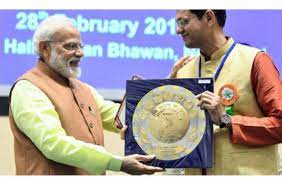
The Council of Scientific and Industrial Research (CSIR) announced the list of awardees for the Shanti Swarup Bhatnagar (SSB) awards for 2022.
- Twelve male scientists were awarded India’s top Shanti Swarup Bhatnagar Prize (SSB) for Science and Technology in 2022. The awards were announced at the inaugural session of the CSIR-NIScPR’s One Week One Lab Programme.
- However, no female scientists have been chosen for this year
- The awards were last announced in 2021
Shanti Swarup Bhatnagar award:
- It is named after the founder Director of the Council of Scientific & Industrial Research (CSIR) India, the late Shanti Swarup Bhatnagar.
- The Prize is given each year for outstanding contributions to science and technology.
- It carries a prize amount of Rs 5,00,000 .
- It is given for notable and outstanding research, applied or fundamental in the following disciplines: (i) Biological Sciences, (ii) Chemical Sciences, (iii) Earth, Atmosphere, Ocean and Planetary Sciences, (iv) Engineering Sciences, (v) Mathematical Sciences, (vi) Medical Sciences and (vii) Physical Sciences.
- Any citizen of India engaged in research in any field of science and technology up to the age of 45 years as reckoned on 31st December of the year preceding the year of the Prize.
- Overseas citizens of India (OCI) and Persons of Indian Origin (PIO) working in India are also eligible.
- The Prize is awarded on the basis of contributions made through work done primarily in India during the five years preceding the year of the Prize.
Nipah Virus : Alert
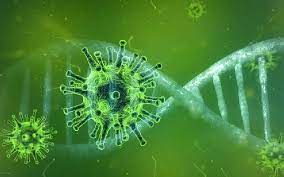
The Kerala health department issued a health alert in Kozhikode after two people who died due to “unnatural” deaths in the district were suspected to have been infected with the Nipah virus (NiV).
- Nipah Virus infection is a zoonotic illness that is transmitted from animals to humans.
- The organism which causes Nipah Virus encephalitis is an RNA or Ribonucleic acid virus of the family Paramyxoviridae, genus Henipavirus, and is closely related to Hendra virus.
- It was first broke out in Malaysia and Singapore in 1998 and 1999.
- It first appeared in domestic pigs and has been found among several species of domestic animals, including dogs, cats, goats, horses and sheep.
- The disease spreads through fruit bats, or ‘flying foxes,’ of the genus Pteropus, who are natural reservoir hosts of the Nipah and Hendra viruses.
- The virus is present in bat urine and, potentially, bat faeces, saliva, and birthing fluids.
- Typically, the human infection presents as an encephalitic syndrome marked by fever, headache, drowsiness, disorientation, mental confusion, coma, and potentially death.
Poila Baisakh As State Foundation Day : West Bengal
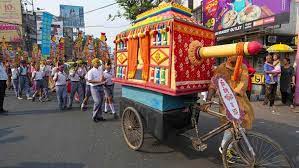
The West Bengal Legislative Assembly recently made a significant decision by declaring ‘Poila Baisakh,’ the first day of the Bengali calendar, as ‘Bangla Dibas’ or West Bengal Foundation Day.
- A dispute emerged earlier in 2023 concerning West Bengal’s Foundation Day when Raj Bhavan officially declared June 20 as the State Foundation Day.
- The Chief Minister of West Bengal argued that June 20, which carries associations with the partition, lacks relevance to the state’s establishment.
- Also, the Assembly approved the proposal to make Rabindranath Tagore’s ‘Banglar Mati Banglar Jol’ the official song of West Bengal.
- Poila Baisakh is an important festival celebrated by Bengali communities across West Bengal, Tripura, Jharkhand, and Assam.
- It is also celebrated in Bangladesh.
- It signifies the Bengali New Year and in 2023 it was celebrated on April 15th.
- On 20th June, 1947, the Bengal Legislative Assembly gathered to make a significant decision about Bengal’s future.
- They had three choices: keep Bengal whole within India, split it into East Bengal and West Bengal for Bengali Muslims and Hindus respectively, or divide it between India and Pakistan.
- After significant rounds of voting, the decision was made to divide Bengal into West Bengal and East Pakistan (which later became Bangladesh) and the Radcliffe Line was drawn later to mark the boundary.
Acharya Vinoba Bhave Birth Anniversary:

The Prime Minister of India paid homage to Acharya Vinoba Bhave on his birth anniversary.
- Vinayak Narahari Bhave was born on September 11, 1895, in Gagode, Bombay Presidency (Maharashtra).
- Vinoba Bhave was a prominent nonviolence activist, freedom fighter, social reformer, and spiritual teacher who followed Mahatma Gandhi’s principles of non-violence and equality.
- He was the inaugural recipient of the international Ramon Magsaysay Award for Community Leadership in 1958 and posthumously received the Bharat Ratna in 1983.
- He actively participated in the non-cooperation movement and encouraged the use of Khadi.
- Vinoba worked to eradicate social inequalities and championed the cause of Harijans (Dalits).
- He initiated the Sarvodaya movement, which included the Bhoodan (Gift of the Land) Movement.
Vidya Samiksha Kendras:

Under the National Digital Education Architecture (NDEAR), the Ministry of Education is pushing the establishment of Vidya Samiksha Kendras (VSKs) across states.
- This initiative aligns with the National Education Policy, 2020.
- Currently, at the Central level, a VSK centre is housed in the Central Institute of Educational Technology building in the National Council for Educational Research and Training (NCERT) campus .
- Vidya Samiksha Kendras (VSKs) is aimed at leveraging data and technology to bring a big leap in learning outcomes.
- This will cover data of more than 15 Lakh schools, 96 Lakh teachers and 26 Crore students and analyze them meaningfully using big data analysis, Artificial Intelligence (AI) and machine learning in order to enhance the overall monitoring of the education system and thereby improving learning outcomes.
- Objectives:
- To monitor the real-time status of various projects/ activities under the ambit of Samagra Shiksha.
- To keep track of enrolled students including learning outcomes, Dropouts, support required by teachers and schools, etc.
- To monitor and track field level academic and non-academic activities at state level and also empower administrators and teachers in the field to take data driven decisions.
- To set up a centralized help desk for grievance redressal mechanisms for stakeholders of the School ecosystem.
- To identify and analyse improvement areas for decision making and implementation that needs urgent attention.
New Spider Species : Discovered

Two new spider species, the Palpimanus Godawan and Palpimanus Maldhok, have been found in the conservation sites of the Rajasthan Desert National Park and Solapur.
- These two species (Godawan and Maldhok) are named in honour of the local name of the Great Indian Bustard.
- The spiders are particularly shy, hiding under rocks or in crevices when disturbed.
- They are maroon in colour, a unique feature they share with the other two known species in their genus, Palpimanidae.
- They are ground species and have heavier bodies; their ability to disperse as spiders do by ballooning, shooting their web, and traipsing from one place to another is limited.
- They stay confined to an area.
Megalithic Dolmen Site : Found

Unique terracotta figurines in different states of preservation have been found in recent archaeological explorations conducted in the megalithic dolmen site at Mudu Konaje, near Moodbidri, in Dakshina Kannada.
- Megalithic culture is known for its different types of burials and use of iron in India. Dolmen is one among them.
- Under a dolmen, huge stone slabs known as orthostats were erected in clockwise order, which created a square room.
- This square chamber was closed by another huge stone slab as a capstone.\
- Generally, on the Eastern slab, a round or U-shaped entrance known as port hole was created.
- It was known by different names in South India, like Kalmane, Pandavara Mane, Moriyara Mane and Moriyara Betta etc., which reveals its popularity among the common people.
- Mudu Konaje site figurines were datable to 800-700 BC.
- It was the biggest megalithic dolmen site, which consisted of nine dolmens on the slope of a stone hill.
- Of the eight figurines found, there are two cow bovines, one mother goddess, two peacocks, a horse, the hand of a mother goddess, and an unknown object.




